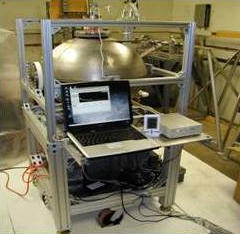Summary
NIST also operates a portable Manganese Sulfate bath that is smaller than the primary bath. The latter feature allows it to measure the emission rate of sources that are 100 times weaker than those that can be measured in the large bath thereby extending by two orders of magnitude our measurement range. The former will make possible a fluence comparison between a radioactive neutron source and a calibrated neutron beam.
Description

A new, reduced-volume manganese bath permits calibration of low-intensity neutron sources as needed for some applications. In addition to its smaller size, it is designed to be portable, and it is side-loaded rather than top-loaded.
The Manganese Sulfate Bath uses a sphere of neutron-absorbing material that surrounds a neutron source. The induced radioactivity is a measure of the neutron source strength. Lower intensity sources provide less manganese activation, resulting in a reduced signal over background, and this signal-to-noise ratio sets the lower limit for sources that can be measured. NIST developed a reduced-volume bath so that a greater fraction of the manganese is close to the source and therefore induces higher manganese activity per unit volume. Unfortunately, the smaller bath also has a higher neutron leakage. The fraction of neutrons leaking from the sphere depends on the neutron spectrum. NIST uses the new bath principally as a means to compare one californium source against another so that the spectrum remains constant. High-fluence Cf-252 sources calibrated in the existing Manganese Sulfate Bath are typically used to calibrate the new bath. The reduced-volume bath has been running continuously for several years. Several test-sources have been calibrated for customers, such as the Department of Homeland Security. The bath has so far been completely free of the usual leakage problems of manganese sulfate systems, and the water-vapor-barrier vent has kept the bath volume very nearly constant.
In addition to its smaller size, this bath has two other special features: it is portable and it is side-loading rather than top-loading. These features allow it to be moved onto a cold neutron beamline and to accept a beam of collimated neutrons that has been calibrated for its flux using the Alpha-Gamma Method. The calibration of the beam will be transferred to the bath, and this will in turn be used to calibrate the national neutron source NBS-1, which for forty years has been the artifact source used by NIST as the lynchpin of its source strength calibrations.

